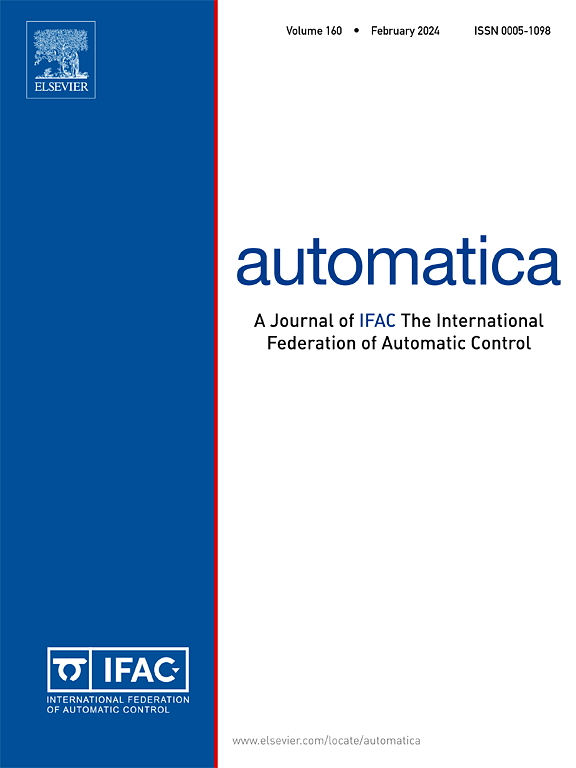Performance-barrier event-triggered control of a class of reaction–diffusion PDEs
IF 4.8
2区 计算机科学
Q1 AUTOMATION & CONTROL SYSTEMS
引用次数: 0
Abstract
We employ the recent performance-barrier event-triggered control (P-ETC) for achieving global exponential convergence of a class of reaction–diffusion PDEs via PDE backstepping control. Rather than insisting on a strictly monotonic decrease of the Lyapunov function for the closed-loop system, P-ETC allows the Lyapunov function to increase as long as it remains below an acceptable performance-barrier. This approach integrates a performance residual—the difference between the value of the performance-barrier and the Lyapunov function—into the triggering mechanism. The integration adds flexibility and results in fewer control updates than with regular ETC (R-ETC) that demands a monotonic decrease of the Lyapunov function. Our P-ETC PDE backstepping design ensures global exponential convergence of the closed-loop system solution to zero in the spatial norm, without encountering Zeno phenomenon. To avoid continuous monitoring of the triggering function that generates events, we develop periodic event-triggered and self-triggered variants (P-PETC and P-STC, respectively) of the P-ETC. The P-PETC only requires periodic evaluation of the triggering function whereas the P-STC preemptively computes the time of the next event at the current event time using the system model and continuously available system states. The P-PETC and P-STC also ensure a Zeno-free behavior and deliver performance equivalent to that of the continuous-time P-ETC which requires continuous evaluation of the triggering function, in addition to the continuous sensing of the state. We provide numerical simulations to illustrate the proposed technique and to compare it with R-ETC associated with strictly decreasing Lyapunov functions.
我们采用最新的性能势垒事件触发控制(P-ETC),通过 PDE 反步控制实现一类反应扩散 PDE 的全局指数收敛。P-ETC 不坚持闭环系统的 Lyapunov 函数严格单调下降,而是允许 Lyapunov 函数上升,只要它保持低于可接受的性能屏障。这种方法将性能残差(性能屏障值与 Lyapunov 函数之间的差值)整合到触发机制中。与要求 Lyapunov 函数单调递减的常规 ETC(R-ETC)相比,这种整合增加了灵活性,并减少了控制更新。我们的 P-ETC PDE 反步进设计确保闭环系统解在空间 L2 规范下全局指数收敛为零,而不会遇到芝诺现象。为了避免持续监控产生事件的触发函数,我们开发了 P-ETC 的周期性事件触发和自触发变体(分别为 P-PETC 和 P-STC)。P-PETC 只需要定期评估触发函数,而 P-STC 则利用系统模型和连续可用的系统状态,在当前事件发生时间预先计算下一个事件的发生时间。P-PETC 和 P-STC 还能确保无 Zeno 行为,其性能与连续时间 P-ETC 相当,后者除了需要连续感知状态外,还需要连续评估触发函数。我们通过数值模拟来说明所提出的技术,并将其与与严格递减 Lyapunov 函数相关的 R-ETC 进行比较。
本文章由计算机程序翻译,如有差异,请以英文原文为准。
求助全文
约1分钟内获得全文
求助全文
来源期刊

Automatica
工程技术-工程:电子与电气
CiteScore
10.70
自引率
7.80%
发文量
617
审稿时长
5 months
期刊介绍:
Automatica is a leading archival publication in the field of systems and control. The field encompasses today a broad set of areas and topics, and is thriving not only within itself but also in terms of its impact on other fields, such as communications, computers, biology, energy and economics. Since its inception in 1963, Automatica has kept abreast with the evolution of the field over the years, and has emerged as a leading publication driving the trends in the field.
After being founded in 1963, Automatica became a journal of the International Federation of Automatic Control (IFAC) in 1969. It features a characteristic blend of theoretical and applied papers of archival, lasting value, reporting cutting edge research results by authors across the globe. It features articles in distinct categories, including regular, brief and survey papers, technical communiqués, correspondence items, as well as reviews on published books of interest to the readership. It occasionally publishes special issues on emerging new topics or established mature topics of interest to a broad audience.
Automatica solicits original high-quality contributions in all the categories listed above, and in all areas of systems and control interpreted in a broad sense and evolving constantly. They may be submitted directly to a subject editor or to the Editor-in-Chief if not sure about the subject area. Editorial procedures in place assure careful, fair, and prompt handling of all submitted articles. Accepted papers appear in the journal in the shortest time feasible given production time constraints.
 求助内容:
求助内容: 应助结果提醒方式:
应助结果提醒方式:


